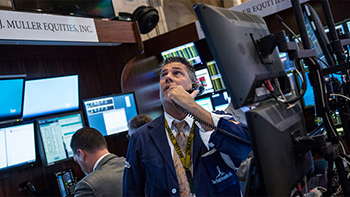(单词翻译:单击)

Since 2011, global trade growth has been stagnant.
全球贸易增长自2011年以来陷入停滞。
With protectionist sentiment intensifying in the US and Europe, and with China appearing to pivot away from export-oriented growth strategies, a hypothesis informally known as peak trade has become increasingly popular.
随着美国和欧洲的保护主义情绪升温,以及中国似乎告别出口导向型的增长策略,一种被非正式称为贸易达到峰值的假说日益流行起来。
According to this view, the past five years of stagnant trade growth is not temporary, but instead reflects fundamental changes to the global economy that will drive continued stagnation in global trade over the next decade and beyond.
按照这种假说,过去5年贸易增长停滞并非是暂时的,而是反映出全球经济基本面的改变,这些改变将推动今后十年甚至更久的全球贸易持续停滞。
This view has important implications for global asset markets in at least two ways.
这种观点至少在两个方面对全球资产市场具有重要潜在影响。
First, trade is often seen as an engine of global growth, and the sputtering of this engine over the past five years (and the idea that it has permanently stalled) has been widely interpreted as an important reason to be sceptical of global growth in the long run — a view that is baked into the very low levels of long-dated bond yields in advanced economies.
首先,贸易往往被视为全球增长引擎,而过去5年这个引擎失去后劲(以及它永久性停摆的观点)被普遍解读为全球长期增长难以为继的重要理由——这种观点导致发达经济体中的长期债券收益率处于非常低的水平。
Second, peak trade implies long-run pessimism for the assets of economies particularly dependent on trade, including many emerging markets.
其次,贸易达到峰值意味着人们对特别依赖贸易的经济体(包括许多新兴市场)的长期资产前景应该感到悲观。
Our recent work, however, pushes back against three key variants of the peak trade hypothesis.
然而,我们最近的研究发现,3种关键的贸易达到峰值的假说不成立。
First, it has been noted that the measured sensitivity of trade growth to GDP growth — the trade beta — has fallen from above 2 in the early 2000s to near, and even below 1; the value at which global trade growth simply keeps up with global GDP growth.
首先,有人指出,贸易增长对GDP增长的可测量敏感度(贸易贝塔系数)从本世纪初的高于2,降至接近甚至低于1的水平;这一水平表明全球贸易增长仅仅与全球GDP增长持平。
However, a detailed look uncovers little convincing evidence that trade has become less responsive to growth over the past 20 years.
然而,仔细研究就会发现,没有令人信服的证据表明贸易对增长的敏感度在过去20年出现下降。
For example, shifts in the measured trade beta fit awkwardly with shifts in global trade growth: estimates of the trade beta increased in the late 1990s (as trade stagnated), then fell dramatically in the early 2000s (as trade boomed), suggesting that we should not read too much into these large recent fluctuations in the measured trade beta.
例如,可测量贸易贝塔系数的变动与全球贸易增长的变动令人尴尬地不能同步;上世纪90年代末贸易贝塔系数估计值上升(这时候贸易停滞),随后在本世纪初大幅下降(这时候贸易繁荣),这似乎表明我们不应过度解读可测量贸易贝塔系数近期的大幅波动。
Second, the global trade slowdown of 2011 was more severe than predicted by observable short-run shocks, prompting many to conclude that forces operating over very long time horizons, and with the potential to drive trade growth still weaker in coming decades, have driven the slowdown.
第二,2011年的全球贸易放缓程度超过了短期剧烈冲击所显示出的水平,这促使许多人断定,推动这一放缓的是长期因素,有可能在今后几十年进一步压低贸易增长。
However, we track the nearly 400,000 separate trade flows over the past 20 years, and find their growth rates have returned to baseline levels that, while low, are close to their longer-run histories.
然而,我们追踪了过去20年近40万项不同的贸易流动,结果发现它们的增速回到了基线水平——尽管低,但接近它们的长期历史水平。
In other words, 2011 was not the beginning (or the middle) of a downward deviation from a 70-year trend of globalisation, but instead marks the end of a decade-long upward deviation from this long-run trend: the trade boom of the 2000s.
换言之,2011年并非是70年全球化趋势下行偏离的开始(或者中途),而是标志着这种长期趋势持续十年的上行偏离(本世纪头十年的贸易繁荣)的结束。
Third, many observers suggest that, by beginning to turn away from export-led growth models, EMs — and especially China — have driven the trade slowdown and will weigh on trade growth in coming decades.
第三,许多观察人士表示,新兴市场(尤其是中国)开始放弃出口导向型增长模式,这推动了贸易放缓,并将在今后几十年抑制贸易增长。
However, we find that a slowdown in the demand for tradeables (not an EM-led turn away from exports), especially in Europe (much more than China), played the most prominent role in driving the trade slowdown.
然而,我们发现,可贸易商品需求放缓(而不是新兴市场主导的告别出口导向模式)在推动贸易放缓方面发挥的作用最为显著,尤其是在欧洲(其影响远远超过中国)。
In its most recent World Economic Outlook report, the IMF reached a similar conclusion about the importance of demand in explaining the trade slowdown.
国际货币基金组织(IMF)在最近的《世界经济展望》(World Economic Outlook)报告中得出了类似的结论,即需求对贸易放缓有着重大影响。
In sum, shifts in global demand will continue to shape how trade evolves in the years ahead.
总之,全球需求变化将继续决定今后多年贸易的演变方式。
Our arguments do not call for a speedy rebound in trade growth, but in our view the distribution of risks to global assets has been too heavily influenced by the idea that positive impulses from trade will never return.
我们并不是说贸易增长将会迅速复苏,而是在我们看来,贸易积极影响永远不会恢复的说法过度影响了全球资产的风险分布。
In particular, while extreme pessimism on global trade has bled significantly into long-run pessimism on global growth, our work uncovers little to suggest that this type of outcome should be seen as the most likely scenario.
尤其是,尽管对全球贸易的极度悲观情绪极大地影响了人们对全球增长前景的悲观看法,但我们的研究发现,几乎没有证据表明应该将这类结果视为最有可能的情景。
Consequently, we push back against the structural negativity around EM assets that we encounter and are more constructive (as we have been since late 2015).
因此,我们不认可围绕新兴市场资产的结构性负面看法——我们的看法更具建设性,就像我们自2015年末以来的那样。
Despite their vulnerability to a long-run stagnation in global trade growth, we think such risks are overemphasised and that EM assets — characterised by much improved external balances, high real yields and unchallenging valuations — are well-positioned to benefit when more favourable trade winds return.
尽管新兴市场资产容易遭受全球贸易增长持续停滞的影响,但我们认为此类风险被过分强调了,新兴市场资产——其特征是外部收支平衡状况大幅改善、实际收益率较高以及估值不高——在更有利的贸易风向回归时将处于有利地位。


